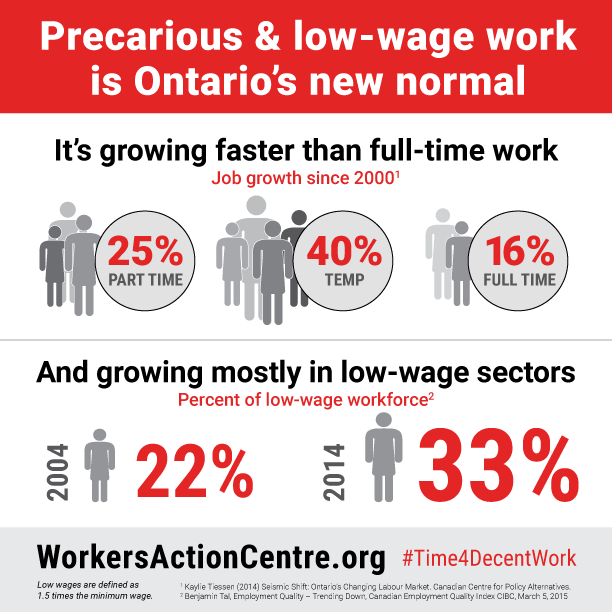We received this question from Raymond W.: “Can you please provide me with any statistics on people who are working and experiencing homelessness in Canadian cities?”
Many people experiencing homelessness struggle to find and keep employment for all kinds of reasons: the difficulty of staying in shelters, facing discrimination from employers and colleagues, being unable to wash up regularly, lacking professional clothing, missing key identification and/or equipment, and many others. Furthermore, sudden job loss and precarious employment are sometimes the triggers that lead to homelessness. So we tend to assume people experiencing homelessness are also unemployed, but this isn’t always true.
In the past few years, journalists have drawn attention to the high numbers of “working homeless” in the U.S. The New York Post profiled city workers in New York City, of which 300 were currently experiencing homelessness. A 2013 story in The New York Times interviewed people working full-time jobs (sometimes more than one) and estimated that 28% of families experiencing homelessness included at least one working adult, and 16% of homeless individuals had jobs. Jeffrey Jones, executive director of the National Coalition Against Homelessness, told Al Jazeera that of the 3.5 million Americans who experience homelessness each year, 25% are employed.
Statistics on Canada’s “working homeless”
Though not given the same media coverage, many people experiencing homelessness in Canada are also employed. A lot of area-specific data is collected during Point-in-Time Counts, which are done by different agencies in each area, and many past surveys have not asked about sources of income or employment. This year marked the first Co-ordinated Point-in-Time Count, which included a core question about how people make money, so newer counts should give us more information about people who are employed and homeless. That said, we have some numbers available from past counts:
Vancouver
- Overall employed: 23%
- Binning: 4%
- Panhandling: 4%
- Sex work: 1%
- Self-employment: 1%
Source: Vancouver Homeless Count 2016
Kelowna
- Overall employed: 6%
- Informally employed: 12%
Source: 2016 Point-in-Time Count, Kelowna, British Columbia
Calgary
- Full-time: 18.3%
- Part-time: 10.4%
- Casual: 28.3%
- Self-employment: 0.8%
Source: 2008 Count of Homeless Persons in Calgary
Regina
- Full-time: 6.3%
- Part-time: 7.8%
- Panhandling: 6.3%
- Under-the-table jobs: 4.7%
- Binning: 3.1%
- Crafting/painting: 1.6%
- Informal (sex work, dealing): 1.6%
Source: Regina 2015 Homeless Count Final Report
Winnipeg
- Overall employed (including temporary and part-time): 16.5%
- Self-employed or informally employed: 18.5%
Source: Winnipeg Street Census 2015
Toronto
- Overall employed: 20%
- Full-time: 5%
- Part-time/casual/seasonal: 12%
- Informal: 6%
Source: 2013 Street Needs Assessment
Montreal
- Full-time: 3%
- Part-time: 4%
- Unreported full-time: 1%
- Unreported part-time: 4%
- Panhandling (informal): 6%
Source: I Count MTL 2015 / Je Compte MTL 2015
Halifax
- Full-time: 4%
- Part-time: 7%
- Casual: 9%
- Informal: 18%
- Other (sex work, petty theft, metal collection): 16%
Source: 2015 Halifax Homeless Point-in-Time Count
Things to consider
I’ve included informal employment (sex work, binning, etc.) because they are often important income sources for people experiencing homelessness. Finding and maintaining formal employment involves many more barriers (like access to professional clothing or equipment) than informal work, and the chaotic nature of being homeless often makes keeping a regular schedule difficult. In many of the surveys, people living on the streets were more likely to report sources of informal income than those who were sheltered.
It’s also important to remember that Point-in-Time Counts only give us a snapshot of who is experiencing homelessness and that they are typically underestimates – especially when it comes to people who are experiencing “hidden homelessness” like staying with friends/family, in hotels or hostels, or couch-surfing; who are also likely to be employed.
How is it possible that working people can be homeless?
While having a stable income is generally key to both finding and keeping housing, having a job isn’t a safeguard against homelessness. A 2013 report by Citizens for Public Justice found that in 44% of poor households, there is at least one working person. Across North America, there’s been growing income disparity and an increasing number of people are classified as “working poor:” people who work but don’t make a living wage. As Richards, Cohen, and Klein wrote in Working For a Living Wage (2010):
A living wage is not the same as the minimum wage, which is the legal minimum employers must pay. The living wage sets a higher test—it reflects what earners in a family need to bring home, based on the actual costs of living in a specific community.
The days of stable, well-paying jobs with good benefits are long gone for many Canadian workers. For a number of years now, the marketplace has trended towards precarious and low-wage employment, which doesn’t offer security or living wages. For people with disabilities or mental health issues, securing and keeping any kind of employment can be extremely difficult, putting them at a higher risk of experiencing homelessness.
These (and other) factors create the conditions of poverty: people living paycheck to paycheck and at the whim of the labour market. With housing prices (both to buy and rent) soaring in most Canadian cities, it's not hard to see why one change in circumstance can result in homelessness. Though the causes of homelessness are complex and often include more than employment status, we must look to income supplements and more affordable housing to help people live above the poverty line and avoid homelessness.
This post is part of our Friday "Ask the Hub" blog series. Have a homeless-related question you want answered? E-mail us at thehub@edu.yorku.ca and we will provide a research-based answer.
Photo credit: Workers Action Centre


